
Douglas is a city in Converse County, Wyoming, United States. The population was 6,120 at the 2010 census. It is the county seat of Converse County and the home of the Wyoming State Fair.
The Northwest Railway Museum (NRM) is a railroad museum in Snoqualmie, King County, Washington. It incorporates a heritage railway, historic depot, exhibit hall, library, and collection care center, and serves more than 130,000 visitors per year.
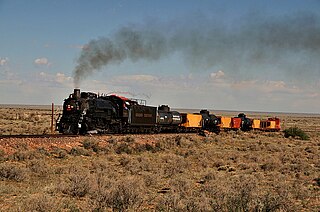
The Grand Canyon Railway, is a heritage railroad which carries passengers between Williams, Arizona and the South Rim of Grand Canyon National Park.
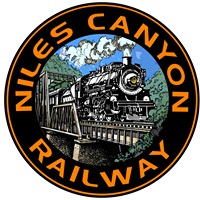
The Niles Canyon Railway (NCRy) is a heritage railway running on the first transcontinental railroad alignment through Niles Canyon, between Sunol and the Niles district of Fremont in the East Bay of the San Francisco Bay Area, in California, United States. The railway is listed on the National Register of Historic Places as the Niles Canyon Transcontinental Railroad Historic District. The railroad is operated and maintained by the Pacific Locomotive Association which preserves, restores and operates historic railroad equipment. The NCRy features public excursions with both steam and diesel locomotives along a well-preserved portion of the First Transcontinental Railroad.
The Fremont, Elkhorn and Missouri Valley Railroad (FE&MV), sometimes called "the Elkhorn," was a railroad established in 1869 in the state of Nebraska in the Midwestern United States.
The Fremont and Elkhorn Valley Railroad was a 17-mile (27 km) heritage railroad headquartered in Dodge County, Nebraska and, offered excursion services on the line. Its equipment is now owned by the Nebraska Railroad Museum.

The Santa Fe Depot in San Diego, California, is a union station built by the Atchison, Topeka and Santa Fe Railway to replace the small Victorian-style structure erected in 1887 for the California Southern Railroad Company. The Spanish Colonial Revival style station is listed on the National Register of Historic Places. Its architecture, particularly the signature twin domes, is often echoed in the design of modern buildings in Downtown San Diego. A wing now houses the downtown branch of the Museum of Contemporary Art San Diego.

Oklahoma City Union Depot is a building in Oklahoma City, Oklahoma that served as a "union station" from 1931 until 1967. It was listed on the National Register of Historic Places in 1979. It now houses the main office of the Central Oklahoma Transportation & Parking Authority.

Williams Depot is a privately owned train station in Williams, Arizona. It is the southern terminus of the Grand Canyon Railway line.

The Atchison, Topeka and Santa Fe Passenger and Freight Complex is a nationally recognized historic district located in Fort Madison, Iowa, United States. It was listed on the National Register of Historic Places in 1992. At the time of its nomination it contained three resources, all of which are contributing buildings. The buildings were constructed over a 24-year time period, and reflect the styles that were popular when they were built. The facility currently houses a local history museum, and renovations are underway to convert a portion of it back to a passenger train depot.

The Kelso Depot, Restaurant and Employees Hotel or Kelso Depot, now also the Mojave National Preserve Visitors Center, is located in the Mojave Desert within the National Park Service Mojave National Preserve, on Kelso Cima Road at the junction of Kelbaker Road in Kelso, California, between Baker and Interstate 15 to the north and Interstate 40 to the south. It was placed on the National Register of Historic Places, and along with the adjacent ghost town of Kelso, was declared a United States Historic District in 2000. The district was increased by a boundary increase approved by the National Park Service in 2019, with reference number 100003401.

Santa Fe 3415 is a preserved class 3400 4-6-2 "Pacific" type steam locomotive built in 1919 by Baldwin for the Atchison, Topeka and Santa Fe Railway. Retired in 1954, it sat in Eisenhower Park in Abilene, Kansas until 1996. At that point, it was put on display in the Abilene and Smoky Valley yard. Restoration began in 2005 and was completed in early 2009. It is planned for the locomotive to operate about once a month during the normal operating season. Its first revenue trip was on May 23, 2009. Today, No. 3415 is owned and operated by the Abilene and Smoky Valley Railroad in Abilene, Kansas.

Santa Fe Depot is the northern terminus of the New Mexico Rail Runner Express commuter rail line. The station was originally built by the Atchison, Topeka and Santa Fe, and until 2014 served as the northern terminus, offices, and gift shop of the Santa Fe Southern Railway, a tourist and freight carrying short line railroad. It is located in Santa Fe, New Mexico at 410 Guadalupe Street, within an area of urban renewal referred to as the "Railyard". Rail Runner service to the station began on December 17, 2008.
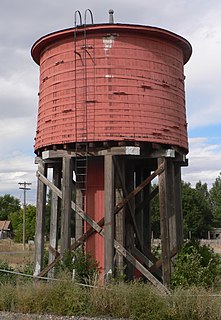
The Lusk Water Tower was built in 1886 to provide water for steam locomotives on the former Fremont, Elkhorn and Missouri Valley Railroad, at Lusk, Wyoming. Lusk itself was built by the railroad at the same time. The tank was originally located in the middle of Lusk near the railroad depot and was moved in 1919 to the present site on the east edge of town, adjacent to what became the Chicago and North Western Transportation Company line now owned by Union Pacific.
Wyoming Central Railway was a railroad in the U.S. state of Wyoming. The railroad was incorporated in October 1885 and built a line from Chadron, Nebraska through Douglas to Casper. The line was initially leased to the Fremont, Elkhorn and Missouri Valley Railroad and the two railroads consolidated in 1891. The FE&MV was merged into Chicago and North Western Transportation Company in 1903 and the line was extended to Lander.
Atchison, Topeka and Santa Fe Railway Depot, or variations with Railroad or Station or Passenger and/or Freight may refer to any one of many stations of the Atchison, Topeka and Santa Fe Railway. These include:
Fremont, Elkhorn and Missouri Valley Railroad Depot may refer to:
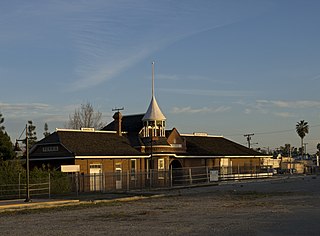
The Perris Depot is a railroad depot built in 1892 to serve Perris, California. The station replaced a previous wooden structure at the same site on the Atchison, Topeka and Santa Fe Railway line, originally the California Southern Railroad.

The Fremont, Elkhorn and Missouri Valley Railroad Depot is a historic train station on South Main Street in Plainview, Pierce County, Nebraska. Built in 1880, it was listed on the National Register of Historic Places in 2005. In 2009, it was serving as the Plainview Historical Museum.
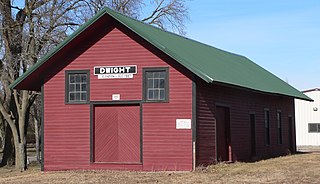
The Fremont, Elkhorn & Missouri Valley Railroad Depot in Dwight, Nebraska was built in 1887 as a railroad depot of the Fremont, Elkhorn & Missouri Valley Railroad. It was later a Chicago & Northwestern Railroad depot. It was listed on the National Register of Historic Places in 1979.
























